Use of Parsing Heuristics in the Comprehension of Passive Sentences: Evidence from Dyslexia and Individual Differences †
Abstract
:1. Introduction
1.1. Good Enough Comprehension
1.2. Comprehension in Dyslexia
1.3. Individual Differences
1.4. Current Study
2. Materials and Methods
2.1. Participants
2.2. Standardised Measures
2.2.1. Rapid Automatised Naming
2.2.2. Working Memory
2.2.3. Verbal Intelligence
2.3. Sentence Processing
2.4. Apparatus
2.5. Design and Procedure
2.6. Data Screening and Analysis
3. Results
3.1. Comprehension Accuracy
3.1.1. Individual Differences
3.2. Eye Movements
3.2.1. Total Reading Times
3.2.2. Individual Differences
3.2.3. Regressions per Sentence
3.2.4. Individual Differences
4. Discussion
4.1. Comprehension Accuracy
4.2. Reading Times
4.3. Parsing Heuristics and Good Enough Comprehension
4.4. Themes of the Special Issue
4.5. Strengths and Limitations
5. Conclusions
Supplementary Materials
Author Contributions
Funding
Institutional Review Board Statement
Informed Consent Statement
Data Availability Statement
Conflicts of Interest
References
- Clark, H.H. Some structural properties of simple active and passive sentences. J. Verbal Learn. Verbal Behav. 1965, 4, 365–370. [Google Scholar] [CrossRef]
- Gough, P.B. The verification of sentences: The effects of delay of evidence and sentence length. J. Verbal Learn. Verbal Behav. 1966, 5, 492–496. [Google Scholar] [CrossRef]
- Herriot, P. The comprehension of active and passive sentences as a function of pragmatic expectations. J. Verbal Learn. Verbal Behav. 1969, 8, 166–169. [Google Scholar] [CrossRef]
- Olson, D.R.; Filby, N. On the comprehension of active and passive sentences. Cogn. Psychol. 1972, 3, 361–381. [Google Scholar] [CrossRef]
- Slobin, D.I. Recall of full and truncated passive sentences in connected discourse. J. Verbal Learn. Verbal Behav. 1968, 7, 876–881. [Google Scholar] [CrossRef]
- de Villiers, J.G.; de Villiers, P.A. Development of the use of word order in comprehension. J. Psycholinguist. Res. 1973, 2, 331–341. [Google Scholar] [CrossRef]
- Hayhurst, H. Some errors of young children in producing passive sentences. J. Verbal Learn. Verbal Behav. 1967, 6, 634–639. [Google Scholar] [CrossRef]
- Precious, A.; Conti-Ramsden, G. Language-impaired children’s comprehension of activeversuspassive sentences. Int. J. Lang. Commun. Disord. 1988, 23, 229–243. [Google Scholar] [CrossRef]
- Sinclair, A.; Sinclair, H.; De Marcelus, O. Young Children’s Comprehension and Production of Passive Sentences. Arch. Psychol. 1971, 41, 161–164. [Google Scholar]
- Ferreira, F.; Bailey, K.G.; Ferraro, V. Good-Enough Representations in Language Comprehension. Curr. Dir. Psychol. Sci. 2002, 11, 11–15. [Google Scholar] [CrossRef]
- Ferreira, F.; Patson, N.D. The ‘Good Enough’ Approach to Language Comprehension. Lang. Linguist. Compass 2007, 1, 71–83. [Google Scholar] [CrossRef]
- Sanford, A.J.; Sturt, P. Depth of processing in language comprehension: Not noticing the evidence. Trends Cogn. Sci. 2002, 6, 382–386. [Google Scholar] [CrossRef]
- Christianson, K.; Hollingworth, A.; Halliwell, J.F.; Ferreira, F. Thematic Roles Assigned along the Garden Path Linger. Cogn. Psychol. 2001, 42, 368–407. [Google Scholar] [CrossRef]
- Ferreira, F.; Christianson, K.; Hollingworth, A. Misinterpretations of Garden-Path Sentences: Implications for Models of Sentence Processing and Reanalysis. J. Psycholinguist. Res. 2001, 30, 3–20. [Google Scholar] [CrossRef]
- Ferreira, F. The misinterpretation of noncanonical sentences. Cogn. Psychol. 2003, 47, 164–203. [Google Scholar] [CrossRef]
- Dick, F.; Elman, J. The frequency of major sentence types over discourse levels: A corpus analysis. Cent. Res. Lang. Newsl. 2001, 13, 1. [Google Scholar]
- Engelhardt, P.E.; Ferreira, F. Processing Coordination Ambiguity. Lang. Speech 2010, 53, 494–509. [Google Scholar] [CrossRef] [PubMed] [Green Version]
- Gigerenzer, G. Why Heuristics Work. Perspect. Psychol. Sci. 2008, 3, 20–29. [Google Scholar] [CrossRef]
- Holbrook, M.B. Bounded rationality: The adaptive toolbox. Psychol. Mark. 2003, 20, 87–92. [Google Scholar] [CrossRef]
- Bishop, D.V.M.; Snowling, M.J. Developmental Dyslexia and Specific Language Impairment: Same or Different? Psychol. Bull. 2004, 130, 858–886. [Google Scholar] [CrossRef] [PubMed] [Green Version]
- Leikin, M.; Bouskila, O.A. Expression of syntactic complexity in sentence comprehension: A comparison between dyslexic and regular readers. Read. Writ. 2004, 17, 801–822. [Google Scholar] [CrossRef]
- de Jong, P.F. Working Memory Deficits of Reading Disabled Children. J. Exp. Child Psychol. 1998, 70, 75–96. [Google Scholar] [CrossRef] [PubMed]
- Tunmer, W.E.; Hoover, W.A. Cognitive and Linguistic Factors in Learning to Read. In Reading Acquisition; Routledge: London, UK, 2017; pp. 175–214. [Google Scholar] [CrossRef]
- Stanovich, K.E. Matthew Effects in Reading: Some Consequences of Individual Differences in the Acquisition of Literacy. Read. Res. Q. 1986, 21, 360–407. [Google Scholar] [CrossRef]
- De Luca, M.; Di Pace, E.; Judica, A.; Spinelli, D.; Zoccolotti, P. Eye movement patterns in linguistic and non-linguistic tasks in developmental surface dyslexia. Neuropsychologia 1999, 37, 1407–1420. [Google Scholar] [CrossRef]
- Hyönä, J.; Olson, R.K. Eye fixation patterns among dyslexic and normal readers: Effects of word length and word frequency. J. Exp. Psychol. Learn. Mem. Cogn. 1995, 21, 1430–1440. [Google Scholar] [CrossRef]
- Wiseheart, R.; Altmann, L.J.P.; Park, H.; Lombardino, L.J. Sentence comprehension in young adults with developmental dyslexia. Ann. Dyslexia 2009, 59, 151–167. [Google Scholar] [CrossRef]
- Schmalz, X.; Altoè, G.; Mulatti, C. Statistical learning and dyslexia: A systematic review. Ann. Dyslexia 2017, 67, 147–162. [Google Scholar] [CrossRef] [PubMed]
- van Witteloostuijn, M.; Boersma, P.; Wijnen, F.; Rispens, J. The contribution of individual differences in statistical learning to reading and spelling performance in children with and without dyslexia. Dyslexia 2021, 27, 168–186. [Google Scholar] [CrossRef] [PubMed]
- Gabay, Y.; Thiessen, E.D.; Holt, L.L. Impaired Statistical Learning in Developmental Dyslexia. J. Speech Lang. Heart Res. 2015, 58, 934–945. [Google Scholar] [CrossRef]
- Dąbrowska, E.; Street, J. Individual differences in language attainment: Comprehension of passive sentences by native and non-native English speakers. Lang. Sci. 2006, 28, 604–615. [Google Scholar] [CrossRef]
- Conners, F.; Olson, R. Reading comprehension in dyslexic and normal readers: A component-skills analysis. In Comprehension Processes in Reading; Lawrence Erlbaum Associates, Inc.: Hillsdale, NJ, USA, 1990; pp. 557–579. Available online: http://psycnet.apa.org/record/1990-97958-025 (accessed on 15 January 2022).
- Nation, K. Children’s Reading Comprehension Difficulties. In Contemporary Perspectives on Reading and Spelling; Wood, C., Connelly, V., Eds.; Routledge: London, UK, 2005; pp. 59–75. Available online: http://psycnet.apa.org/record/2005-06969-014 (accessed on 13 January 2022).
- Nation, K.; Snowling, M.J. Individual Differences in Contextual Facilitation: Evidence from Dyslexia and Poor Reading Comprehension. Child Dev. 1998, 69, 996–1011. [Google Scholar] [CrossRef]
- Just, M.; Carpenter, P.A. A capacity theory of comprehension: Individual differences in working memory. Psychol. Rev. 1992, 99, 122–149. [Google Scholar] [CrossRef] [PubMed]
- King, J.; Just, M. Individual differences in syntactic processing: The role of working memory. J. Mem. Lang. 1991, 30, 580–602. [Google Scholar] [CrossRef]
- Caplan, D.; DeDe, G.; Waters, G.; Michaud, J.; Tripodis, Y. Effects of age, speed of processing, and working memory on comprehension of sentences with relative clauses. Psychol. Aging 2011, 26, 439–450. [Google Scholar] [CrossRef] [PubMed]
- Caplan, D.; Waters, G.S. Verbal working memory and sentence comprehension. Behav. Brain Sci. 1999, 22, 77–94. [Google Scholar] [CrossRef]
- Daneman, M.; Carpenter, P.A. Individual differences in working memory and reading. J. Verbal Learn. Verbal Behav. 1980, 19, 450–466. [Google Scholar] [CrossRef]
- Waters, G.S.; Caplan, D. Processing resource capacity and the comprehension of garden path sentences. Mem. Cogn. 1996, 24, 342–355. [Google Scholar] [CrossRef] [PubMed] [Green Version]
- Denckla, M.B.; Rudel, R.G. Rapid ‘automatized’ naming (R.A.N.): Dyslexia differentiated from other learning disabilities. Neuropsychologia 1976, 14, 471–479. [Google Scholar] [CrossRef]
- Gathercole, S.E.; Alloway, T.P.; Willis, C.; Adams, A.-M. Working memory in children with reading disabilities. J. Exp. Child Psychol. 2006, 93, 265–281. [Google Scholar] [CrossRef] [Green Version]
- Jeffries, S.; Everatt, J. Working memory: Its role in dyslexia and other specific learning difficulties. Dyslexia 2004, 10, 196–214. [Google Scholar] [CrossRef]
- Jones, M.W.; Branigan, H.P.; Kelly, M.L. Dyslexic and nondyslexic reading fluency: Rapid automatized naming and the importance of continuous lists. Psychon. Bull. Rev. 2009, 16, 567–572. [Google Scholar] [CrossRef] [PubMed]
- Wolf, M.; Bowers, P.G.; Biddle, K. Naming-Speed Processes, Timing, and Reading. J. Learn. Disabil. 2000, 33, 387–407. [Google Scholar] [CrossRef] [PubMed]
- Engelhardt, P.E.; Nigg, J.T.; Carr, L.A.; Ferreira, F. Cognitive inhibition and working memory in attention-deficit/hyperactivity disorder. J. Abnorm. Psychol. 2008, 117, 591–605. [Google Scholar] [CrossRef] [PubMed] [Green Version]
- Stella, M.; Engelhardt, P.E. Syntactic ambiguity resolution in dyslexia: An examination of cognitive factors underlying eye movement differences and comprehension failures. Dyslexia 2019, 25, 115–141. [Google Scholar] [CrossRef] [Green Version]
- Engelhardt, P.E.; Nigg, J.T.; Ferreira, F. Executive Function and Intelligence in the Resolution of Temporary Syntactic Ambiguity: An Individual Differences Investigation. Q. J. Exp. Psychol. 2017, 70, 1263–1281. [Google Scholar] [CrossRef] [Green Version]
- Van Dyke, J.A.; Johns, C.L.; Kukona, A. Low working memory capacity is only spuriously related to poor reading comprehension. Cognition 2014, 131, 373–403. [Google Scholar] [CrossRef] [PubMed] [Green Version]
- Wagner, R.K.; Torgesen, J.K.; Rashotte, C.A.; Pearson, N.A. Comprehensive Test of Phonological Processing, 2nd ed.; PRO-ED: Austin, TX, USA, 2013. [Google Scholar] [CrossRef]
- Unsworth, N.; Heitz, R.P.; Schrock, J.C.; Engle, R.W. An automated version of the operation span task. Behav. Res. Methods 2005, 37, 498–505. [Google Scholar] [CrossRef] [Green Version]
- Conway, A.R.A.; Kane, M.J.; Bunting, M.F.; Hambrick, D.Z.; Wilhelm, O.; Engle, R.W. Working memory span tasks: A methodological review and user’s guide. Psychon. Bull. Rev. 2005, 12, 769–786. [Google Scholar] [CrossRef]
- Wechsler, D. Wechsler Adult Intelligence Scale- Fourth Edition (WAIS-IV); Psychological Corporation: San Antonio, TX, USA, 2014. [Google Scholar]
- Benson, N.; Hulac, D.M.; Kranzler, J.H. Independent examination of the Wechsler Adult Intelligence Scale—Fourth Edition (WAIS-IV): What does the WAIS-IV measure? Psychol. Assess. 2010, 22, 121–130. [Google Scholar] [CrossRef] [Green Version]
- Brown, W. Some experimental results in the correlation of mental abilities. Br. J. Psychol. 1910, 3, 296–322. [Google Scholar] [CrossRef]
- Spearman, C. Correlation calculated from faulty data. Br. J. Psychol. 1910, 3, 271–295. [Google Scholar] [CrossRef]
- R Core Team. R: A Language and Environment for Statistical Computing; R Foundation for Statistical Computing; R Core Team: Vienna, Austria, 2018; Available online: https://www.R-project.org/ (accessed on 12 December 2019).
- Bates, D.M.; Maechler, M.; Bolker, B.; Walker, S. Lme4: Linear Mixed-Effects Models Using S4 Classes; R Package Version 1.1-18-1. 2018. Available online: https://cran.r-project.org/web/packages/lme4/index.html (accessed on 15 December 2019).
- Barr, D.J.; Levy, R.; Scheepers, C.; Tily, H.J. Random effects structure for confirmatory hypothesis testing: Keep it maximal. J. Mem. Lang. 2013, 68, 255–278. [Google Scholar] [CrossRef] [PubMed] [Green Version]
- Patson, N.D.; Darowski, E.S.; Moon, N.; Ferreira, F. Lingering misinterpretations in garden-path sentences: Evidence from a paraphrasing task. J. Exp. Psychol. Learn. Mem. Cogn. 2009, 35, 280–285. [Google Scholar] [CrossRef] [PubMed] [Green Version]
- Perfetti, C.A. Reading Ability; Oxford University Press: New York, NY, USA, 1985. [Google Scholar]
- Perfetti, C. Reading Ability: Lexical Quality to Comprehension. Sci. Stud. Read. 2007, 11, 357–383. [Google Scholar] [CrossRef]
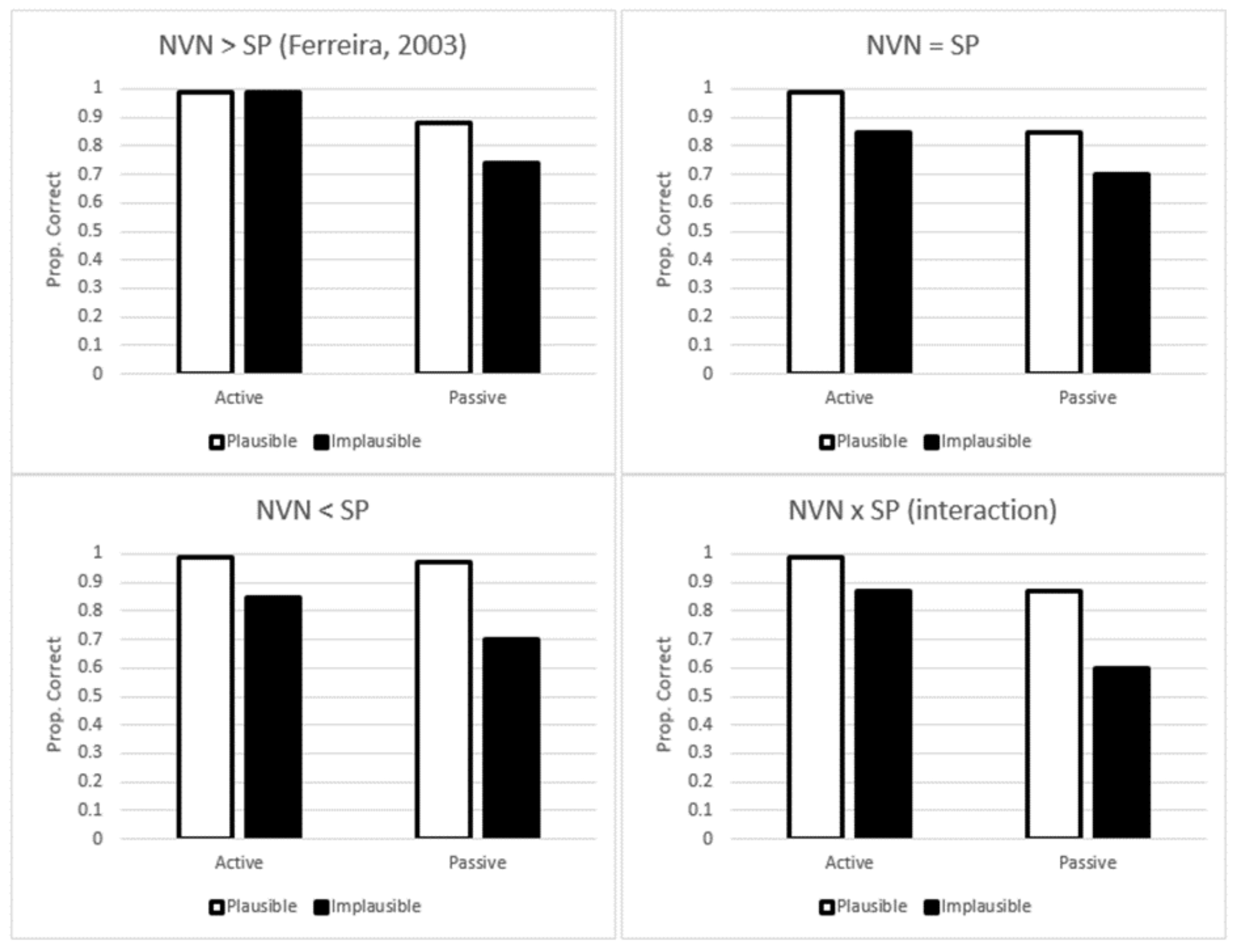
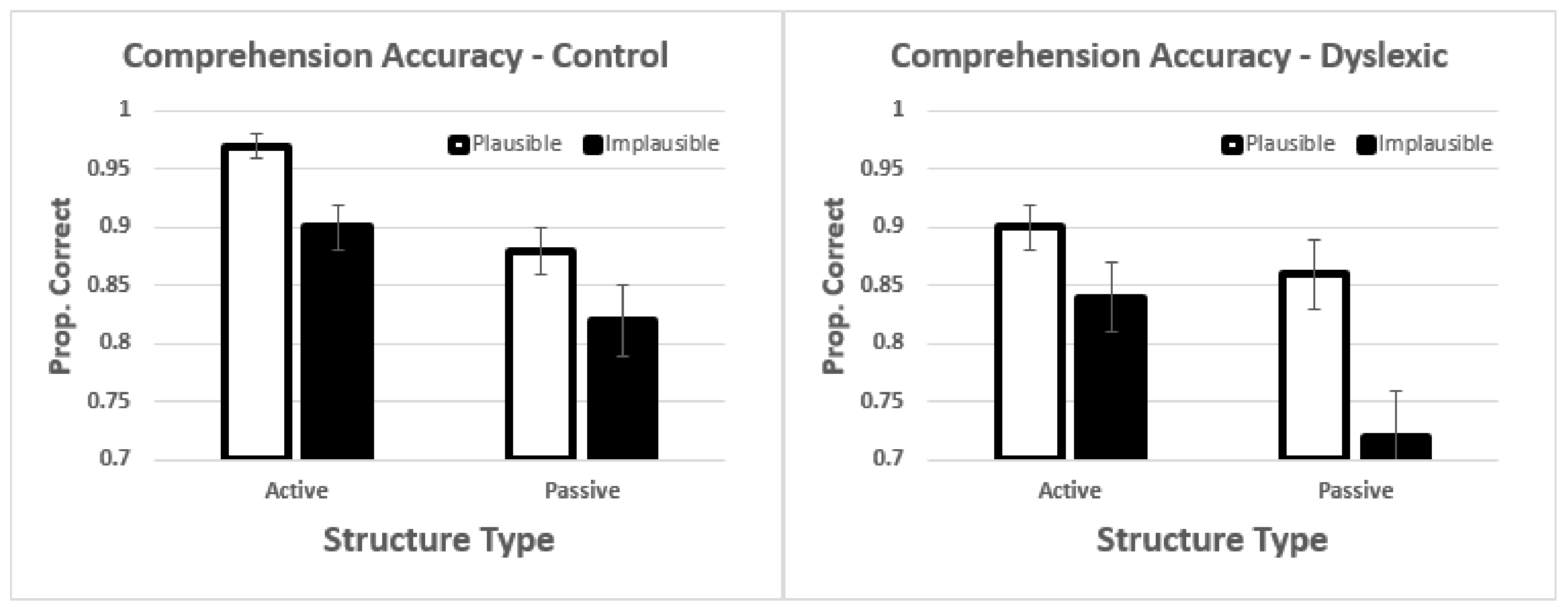
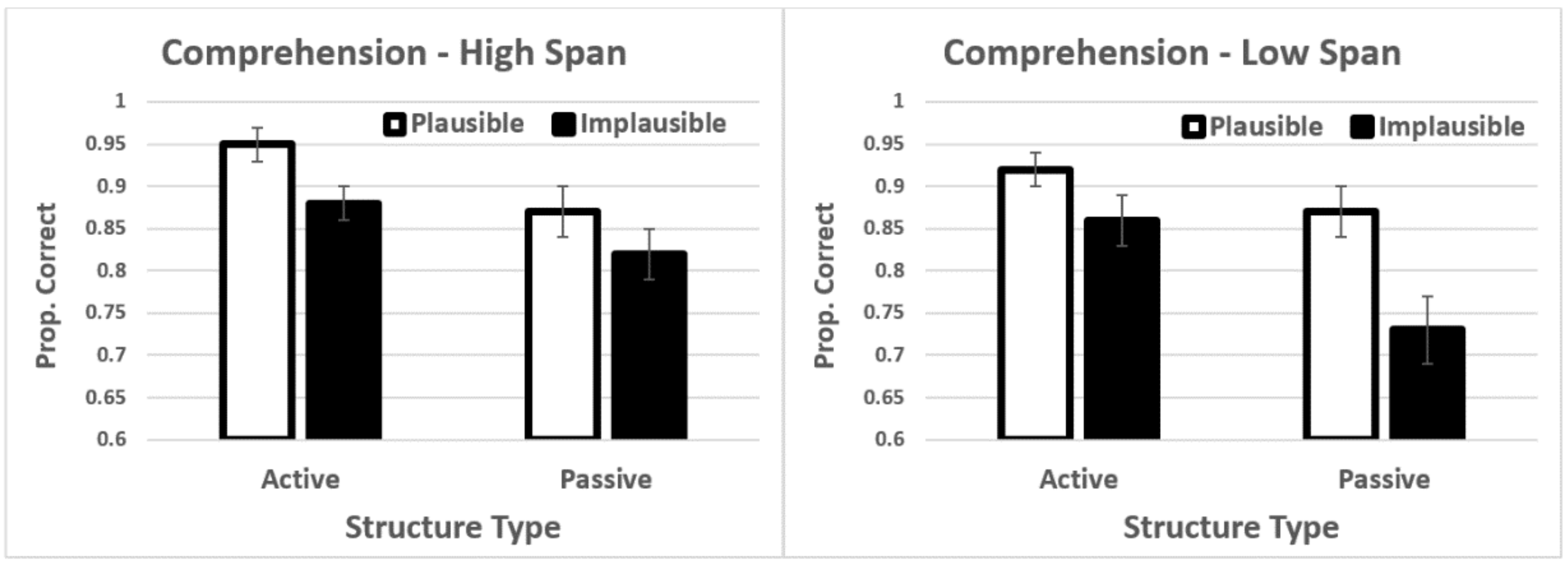

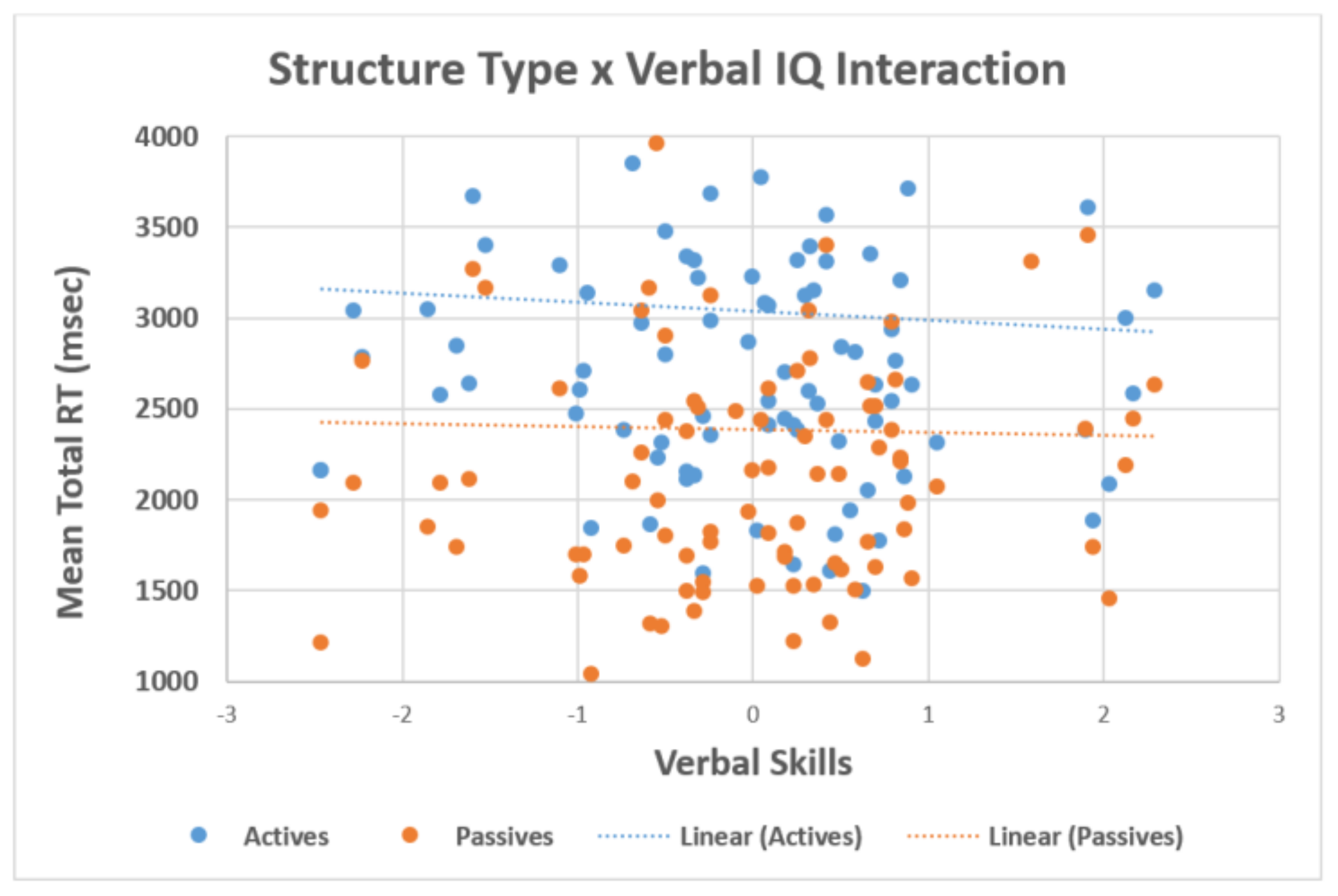
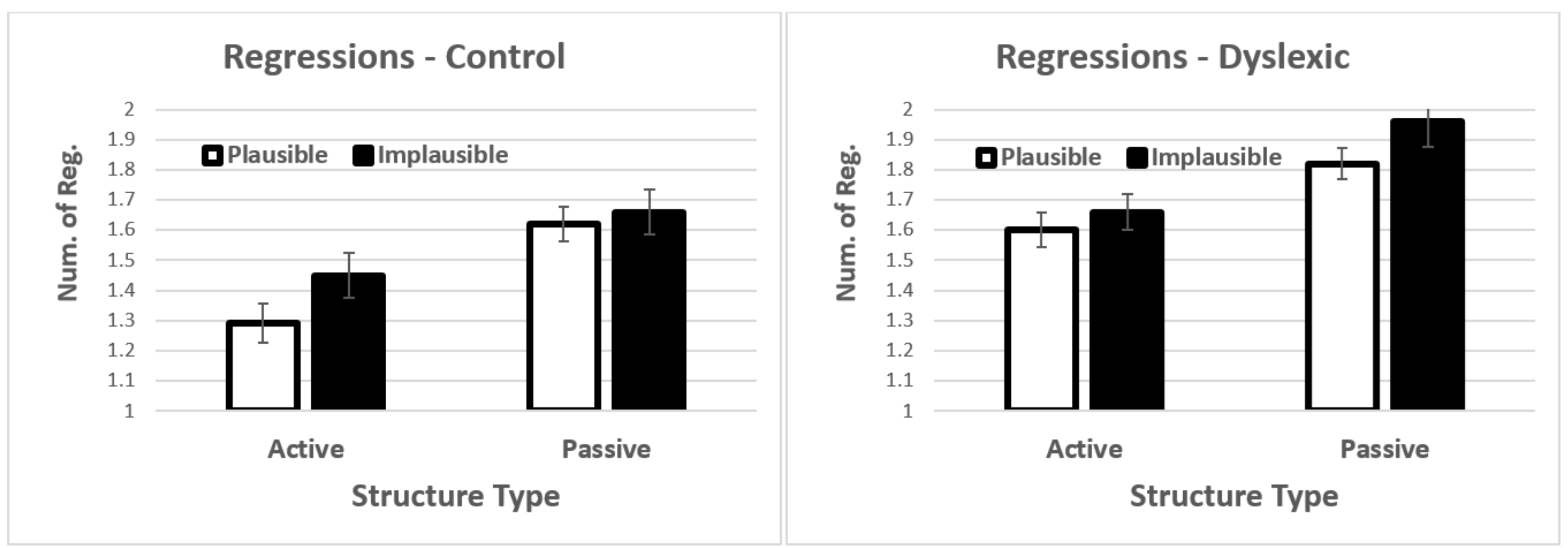

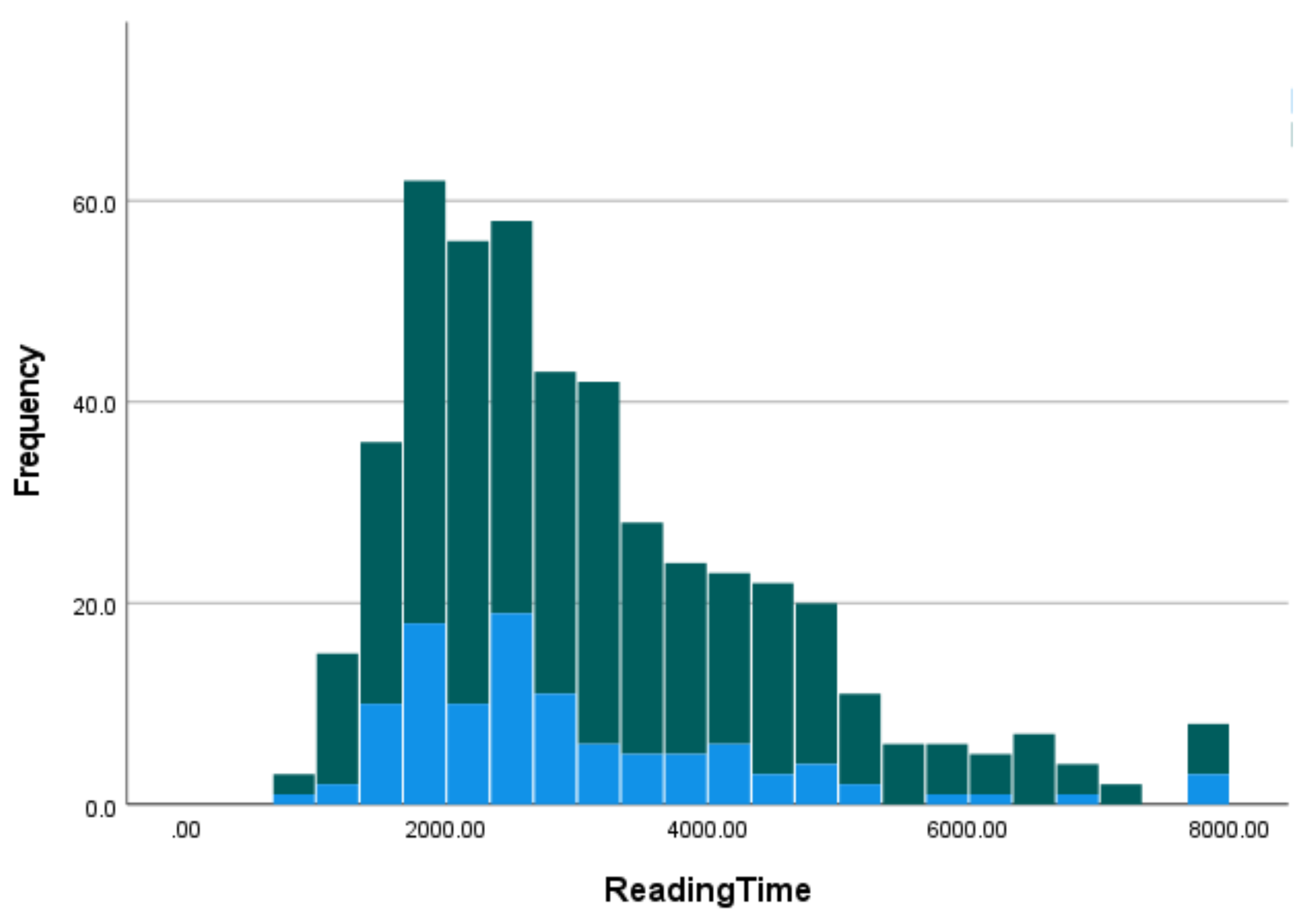
| Actives | |
|---|---|
| 1. The dog bit the man. (Plausible) | Did the man bite the dog? |
| 2. The man bit the dog. (Implausible) | Did the dog bite the man? |
| Passives | |
| 3. The man was bitten by the dog. (Plausible) | Did the man bite the dog? |
| 4. The dog was bitten by the man. (Implausible) | Did the dog bite the man? |
| Controls (n = 50) | Dyslexia (n = 50) | t-Value | |
|---|---|---|---|
| Variable | Mean (SD) | Mean (SD) | |
| Age (years) | 20.31 (1.22) | 21.7 (2.67) | t (98) = 3.34 *** |
| Gender (% men) | 8 | 34 | t (98) = 3.33 *** |
| RAN Letters (seconds) | 12.46 (2.59) | 16.50 (6.20) | t (98) = 4.25 *** |
| RAN Numbers (seconds) | 11.44 (2.43) | 15.26 (5.29) | t (98) = 4.64 *** |
| Similarities | 93.5 (8.65) | 98.8 (11.76) | t (98) = −2.57 * |
| Vocabulary | 99.9 (9.18) | 101.3 (9.02) | t (98) = −0.77 |
| Comprehension | 93.5 (10.70) | 94.3 (9.31) | t (98) = 0.40 |
| Verbal IQ (latent) | 0.152 (0.98) | 0.152 (1.00) | t (98) = −1.53 |
| Rotation Span | 17.7 (7.23) | 16.9 (8.04) | t (98) = 0.51 |
| Variable | 1 | 2 | 3 | 4 | 5 | 6 | 7 | 8 | 9 |
|---|---|---|---|---|---|---|---|---|---|
| 1. Age | - | 0.35 ** | 0.32 ** | 0.16 | 0.04 | 0.19 # | −0.06 | 0.06 | 0.02 |
| 2. Gender | - | 0.32 ** | 0.13 | 0.30 ** | 0.00 | 0.05 | 0.00 | 0.11 | |
| 3. Dyslexia Status | - | −0.05 | 0.15 | −0.29 ** | −0.18 # | −0.07 | −0.20 # | ||
| 4. Rotation Span | - | −0.04 | 0.26 ** | 0.10 | 0.00 | 0.20 * | |||
| 5. Verbal Skills | - | 0.03 | 0.27 ** | 0.10 | 0.13 | ||||
| 6. Active-plausible | - | 0.37 ** | 0.33 ** | 0.45 ** | |||||
| 7. Active-implausible | - | 0.26 ** | 0.34 ** | ||||||
| 8. Passive-plausible | - | 0.39 ** | |||||||
| 9. Passive-implausible | - |
| Variable | 1 | 2 | 3 | 4 | 5 | 6 | 7 | 8 | 9 |
|---|---|---|---|---|---|---|---|---|---|
| 1. Age | - | 0.35 ** | 0.32 ** | 0.16 | 0.04 | −0.07 | −0.07 | 0.00 | −0.02 |
| 2. Gender | - | 0.32 ** | 0.13 | 0.30 ** | 0.11 | 0.05 | 0.14 | 0.17 | |
| 3. Dyslexia Status | - | −0.05 | 0.15 | 0.33 ** | 0.26 * | 0.27 ** | 0.31 ** | ||
| 4. Rotation Span | - | −0.04 | −0.33 ** | −0.27 ** | −0.10 | −0.19 | |||
| 5. Verbal Skills | - | −0.08 | −0.12 | −0.02 | 0.08 | ||||
| 6. Active-plausible | - | 0.72 ** | 0.67 ** | 0.73 ** | |||||
| 7. Active-implausible | - | 0.60 ** | 0.69 ** | ||||||
| 8. Passive-plausible | - | 0.73 ** | |||||||
| 9. Passive-implausible | - |
Publisher’s Note: MDPI stays neutral with regard to jurisdictional claims in published maps and institutional affiliations. |
© 2022 by the authors. Licensee MDPI, Basel, Switzerland. This article is an open access article distributed under the terms and conditions of the Creative Commons Attribution (CC BY) license (https://creativecommons.org/licenses/by/4.0/).
Share and Cite
Stella, M.; Engelhardt, P.E. Use of Parsing Heuristics in the Comprehension of Passive Sentences: Evidence from Dyslexia and Individual Differences. Brain Sci. 2022, 12, 209. https://doi.org/10.3390/brainsci12020209
Stella M, Engelhardt PE. Use of Parsing Heuristics in the Comprehension of Passive Sentences: Evidence from Dyslexia and Individual Differences. Brain Sciences. 2022; 12(2):209. https://doi.org/10.3390/brainsci12020209
Chicago/Turabian StyleStella, Marianna, and Paul E. Engelhardt. 2022. "Use of Parsing Heuristics in the Comprehension of Passive Sentences: Evidence from Dyslexia and Individual Differences" Brain Sciences 12, no. 2: 209. https://doi.org/10.3390/brainsci12020209
APA StyleStella, M., & Engelhardt, P. E. (2022). Use of Parsing Heuristics in the Comprehension of Passive Sentences: Evidence from Dyslexia and Individual Differences. Brain Sciences, 12(2), 209. https://doi.org/10.3390/brainsci12020209







